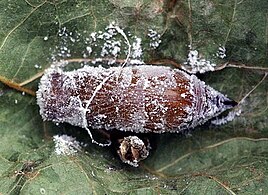Long-tailed skipper
| Long-tailed skipper | |
|---|---|

| |
| Scientific classification | |
| Domain: | Eukaryota |
| Kingdom: | Animalia |
| Phylum: | Arthropoda |
| Class: | Insecta |
| Order: | Lepidoptera |
| Family: | Hesperiidae |
| Genus: | Urbanus |
| Species: | U. proteus
|
| Binomial name | |
| Urbanus proteus | |
The long-tailed skipper (Urbanus proteus) is a
spread-winged skipper butterfly found throughout tropical and subtropical South America, south to Argentina and north into the eastern United States and southern Ontario.[2]
It cannot live in areas with prolonged frost. It is a showy butterfly, with wings of light brown tinted with iridescent blue, and two long tails extending from the hindwings. The robust body is light blue dorsally. It has a large head, prominent eyes, and a wingspan between 4.5 and 6 centimeters.
Life cycle
It lays white or yellow eggs, singly or in small clusters, which hatch into a caterpillar with a yellowish body and large, dark head. After two to three weeks, the caterpillar forms a pupa. Its pupa is contained in a rolled leaf and covered in fine bluish hairs. The pupa stage may last from one to three weeks, after which the adult emerges.[3]
The caterpillar of this skipper is a common pest of
nuclear polyhedrosis virus killed up to 50% of the larvae.[3]
Sub-species
U. p. domingo flies in the Bahamas and throughout the West Indies, but it is only weakly differentiated from the nominate form, chiefly by its reduced white markings.[4]
-
Pupa
-
Caterpillar
-
U. p. domingo, Jamaica
-
U. p. domingo, Grand Cayman
References
- ^ "NatureServe Explorer 2.0 Urbanus proteus Long-tailed Skipper". explorer.natureserve.org. Retrieved 29 September 2020.
- ^ "Urbanus proteus". Global Biodiversity Information Facility. Retrieved 19 October 2021.
- ^ ISBN 978-0-12-158861-8.
- ISBN 978-87-88757-85-9, pp. 117-119
- Butterflies and Moths of North America Fact Page
- U. proteus on the UF/IFAS Featured Creatures Web site
- Butterflies of Houston and Southeast Texas, by John & Gloria Tveten






